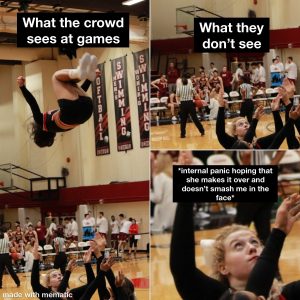10
Whitney Groeger

Cheerleading is my life. I have been a cheerleader for 12 years and am getting excited about the next coming season of my 13th year. What many people don’t understand about cheerleading is that it is more than just the waving of pompoms and looking all glammed up for games (which yes, is a big part of it). Cheerleading is not only a sport, it’s also a leadership and ambassador role for your school. Not only are we as cheerleaders expected to show up to every game (with the full get up) but many times we are called to lead in other ways such as going to pep rallies and taking photos with fans.
One of the hardest parts of cheerleading is all the labels that we receive. Although some labels can be positive (peppy, happy, etc) many are not. I’m sure we are all familiar with the “dumb” cheerleader assumption and can see how hurtful this could play out when you’re on the other side. What people often forget is that although we have this esteemed title of ‘cheerleader’ we’re also human. We have feelings and emotions and personalities that are each unique to each of our lived experiences, which often don’t fit into the box of the ‘cheerleader’ stereotype. Regardless, these assumptions often make people highly critical of us cheerleaders because of the time we spend in the public eye.
I have personally experienced many people judging my weight and height because I don’t seem to fit the visual expectations of “what a cheerleader should be”. Which is sad when you think about it. Especially when you consider how young some of us cheerleaders start. All it takes sometimes is one adult giving you the once over to reconsider even wanting to cheer in the first place. Nobody should be made to feel bad about things that bring them joy, especially children. To combat this, many of us who have been in the cheerleading world have been trying to have these conversations with people to expand the narrative of “Bring-it-On!” cheerleading that many have accepted to be reality. With these kinds of conversations and with the addition of the internet/social media the mass view of cheerleading in the public eye has begun to evolve over the years (especially with the release of the Netflix special “Cheer” that reached a wider audience). But despite these advances in the image of cheerleading we still have a long way to go. Being a cheerleader is still often one of the hardest sports both emotionally and physically, I can personally attest to this. I mean come on, no other sport would be judged if their hair looked bad or if they had a bruise on their leg. Being in the public eye like that is hard as an adult, let alone as a kid.
 At the beginning of my journey, I was so excited for all the possibilities but so scared that I wasn’t going to fit the mold because I had only been told one narrative of what a cheerleader was supposed to be like and I didn’t think that was me. This is so common throughout adolescence and that’s where a good coach can be there to show their athletes that cheerleading is more than what’s on the outside; it’s about putting in the work. That leads me to you! So you want to either become a better coach or you want to start off your coaching on a good note, right? Here are the three best ways that you can positively use cognition and psychology to be a better coach and leader!
At the beginning of my journey, I was so excited for all the possibilities but so scared that I wasn’t going to fit the mold because I had only been told one narrative of what a cheerleader was supposed to be like and I didn’t think that was me. This is so common throughout adolescence and that’s where a good coach can be there to show their athletes that cheerleading is more than what’s on the outside; it’s about putting in the work. That leads me to you! So you want to either become a better coach or you want to start off your coaching on a good note, right? Here are the three best ways that you can positively use cognition and psychology to be a better coach and leader!
1. Use multiple forms of teaching!
Often coaches forget that there is power in using multiple different forms of learning beyond just the kinesthetic. (Although yes that can be helpful as well). One example of this, that some of my past coaches utilized, was having me write down or copy chants and cheers. The act of both reading and writing these cheers helped to solidify them to memory. Though this may seem like a simple addition it can make all the difference in helping memorize the often daunting list that needs to be ready for game day. Another example of another form that you can use in coaching your cheerleaders is using cadences. For all you non-musical people a cadence is simply the rhythm to which a song (or in this case chant) follows. Reinforcing this pulse to the cheers can help your athletes to remember them and in some cases help distinguish similar cheers. I know for me I was always a very musical kid and this was a very crucial step to the learning process. Once your cheerleaders have the cheer or chant down, it makes any according moves that much easier to learn! Breaking it down into words and motions separately helps to lessen the overwhelming feeling that can often follow in our particular sport. Kids are resilient and can take on a lot, but if you give it all to them all at one time this can lead to feelings of incompetence and doubt. To combat that, break these things into smaller bits to make them easier to digest. Breaking the material into smaller pieces will help keep motivations high and thus the fragile adolescent self worth as well. Self worth is an important thing to build in adolescence and as you will learn, being a coach is about more than just believing in your athletes, it’s about giving your athletes the space and guidance to be able to believe in themselves (Kleinknecht, 2014).
2. Discuss the labels!
Now, this was one point that I wish my coaches growing up had discussed more! As a kid, it was still “cute” to be a cheerleader and so many of my coaches did not talk about the negative labels/stereotypes side to cheerleading. Yes, cheerleading is a fantastic sport with so many different facets but at the same time, there is still a negative connotation associated with it and avoiding it will only hurt your athletes in the long run. Instead of pretending that these labels (both good and bad) don’t exist or that they won’t come to fruition, talk to your athletes about them. If you don’t discuss these labels with your athletes they will internalize them and thus may come to the conclusion that only a particular person can even be a cheerleader. As coaches we need to stop this from happening by putting the focus on the action of the sport. Cheerleading isn’t a type of person or an IQ, it is an action that anybody can actively participate in and it’s essential in making this known to your athletes. With that said, as your athletes begin to participate, they will begin to claim their identity within cheerleading. Our identities as human beings are how we make sense of the world and they are especially crucial in adolescence as this is when they are beginning to develop. Due to this, as a coach it is very important to discuss how these labels/stereotypes can affect them both emotionally and physically. I have seen many cheerleaders who have spiraled down the path of eating disorders, body image issues, and depression; those can be a huge part of the experience, especially if you never openly talk about it. While you can’t totally protect your cheerleaders from everything the world has to throw at them, having a coach that has these difficult conversations as well as makes their athletes feel wanted and beautiful can make all the difference in the long run. You can do this by using positive affirmations with your team. Now I’m not saying you have to sugar coat everything, but make sure that you help them to relabel themselves as “strong” and “athletic” which reinforces the action rather than the type of person that they are. We as humans like to put things into categories, it’s just in our nature. Just be sure that your athletes are putting themselves into these positive categories with things that are actually in their control. After all, a healthy mindset is really the key to achieving success in any area of your life and it starts with addressing the labels that we limit ourselves to, especially the ones given at a young age which can often stick with us the rest of our lives. As a coach, you have the unique opportunity to affect a kid’s life for better or worse, and understanding the psyche behind your athletes and what motivates them will help that process to occur in a positive light. (Kleinknecht, 2012).
3. Use Technology to your advantage!
What a time to be alive! Here in this era technology is so accessible to all of your athletes. Utilize it! In my experience, coaches have used it to help keep in communication with the team, keep our schedule on track, and to organize material. Be creative with this! In the past, I have had coaches who have assigned video routines over breaks. Though I personally really struggled to learn these routines on my own, for others, it was a relief so that they could learn things at their own pace. The visual stimulus via video can actually help to form a memory in a different way and some athletes may find this helpful in recall later. Though the idea of “learning types” is a myth, many athletes have different methods they may prefer and a good coach can teach all styles to help facilitate a more emotional connection to the material. Kids today have grown up in the digital age therefore many may connect more with a visual stimulus. While of course seeing it in person may be the most helpful, having a reference video to refer to or learn from can enhance their visual stimulation as well and thus increase their recall of information later. This is something that you will have to communicate with your team. Find what helps your athletes to connect with the material and run with it, there’s really not a bad way to go about it. Sometimes even simply the variety of teaching styles is enough to keep your athletes in maximum engagement and thus maximum motivation. When the motivation is high, the performance level will follow suit and you will have a product both team and coach can be proud of. (Grushka, et al, 2018)
Once you can use a variety of different teaching styles, discuss the many different labels within cheerleading, and use technology to your advantage, you are on the road to becoming a successful coach! The best coaches have a willingness to grow and learn right along with their team and this starts by understanding the cognition and psychology behind your athletes.
References
Grushka, K. Hope. A., Clement, N., Lawry, M., & Devine, A. (2018). New visuality in Art/Science: A pedagogy of connection for cognitive growth and creativity. Peabody Journal of Education, 93, 320 – 331. Doi: https://doi.org/10.1080/0161956X.2018.1449927
Kleinknecht, E. (2014, January 18). Embracing Embodiment. Cognitioneducation. https://cognitioneducation.me/2014/01/18/embracing-embodiment/
Kleinknecht, E. (2012, February 24). Labels on the Brain. Cognitioneducation. https://cognitioneducation.me/2012/02/24/labels-on-the-brain/
